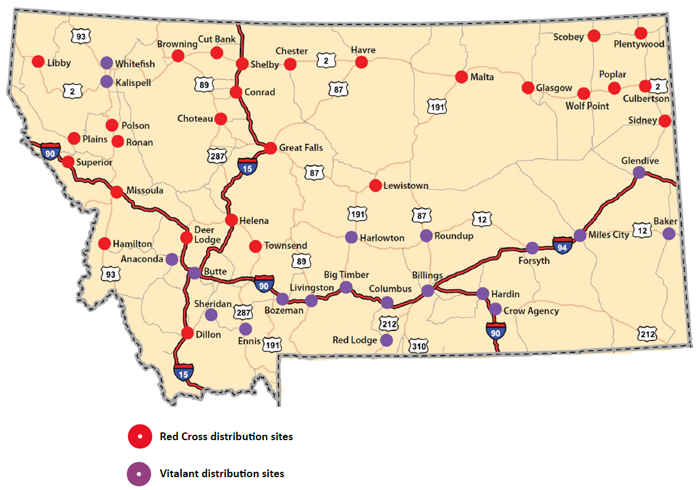Montana Interfacility Blood Network (MT IBN)
- Need: To provide blood transfusions in the ambulance on the way to a hospital.
- Intervention: The Montana Interfacility Blood Network includes 48 healthcare facilities that stock blood and allow ambulances to pick up units of blood while transporting a patient.
- Results: Since its launch, the network has helped at least three patients.
Description
In 2019, a woman in Montana suffered a ruptured ectopic pregnancy and significant blood loss. The ambulance carrying her had to drive 2.5 hours through a snowstorm to an advanced trauma center. The woman survived, but the incident made the Montana State Trauma Care Committee consider how to improve care in these emergency situations.
Committee members realized that the ambulance carrying the woman had passed two hospitals that stocked blood on the way to the advanced trauma center. This realization led committee members to create the Montana Interfacility Blood Network (MT IBN), which allows ambulance crews to pick up blood from participating hospitals and begin transfusion in the ambulance.
Services offered
The Montana State Trauma Care Committee created a map of the 48 healthcare facilities in the state that stocked blood. Then it created guidelines for ambulances, blood banks, hospitals, and labs about packaging and transporting blood, documentation, communication, and billing.

An ambulance crew picks up blood from a participating hospital (or hospitals, depending on the amount of blood available or needed). In one case, a police officer picked up the blood and met the ambulance at a highway exit.
The MT IBN uses type O red blood cells since there is no time to test a patient's blood type in an emergency and patients may not accurately remember their blood type. The hospital receiving the patient bills the patient's insurance for the blood.
Results
Since its launch in 2022, the Montana Interfacility Blood Network has helped at least three patients.
Montana's trauma system manager said that other states have expressed interest in creating a similar program.
For its work on the MT IBN, the Montana State Trauma Care Committee won the 2024 Peregrine Award in the Level III, IV and V Trauma Centers Category.
The MT IBN was featured in the June 2024 KFF Health News article Montana Creates Emergency 'Drive-Thru' Blood Pickup Service for Rural Ambulances.
For more information about this network, including some safety guidelines:
Riha, G.M., Johnson, A., Arnold, S., Englehart, M.S., & Thompson, S.J. (2024). The Montana Interfacility Blood Network: A Novel Lifesaving “Hand-off” for the Optimal Care of Rural Patients. Journal of Blood Medicine, 15, 141-146.
Challenges
Not every rural hospital has the space, money, or qualified staff for a blood bank. Others may not be able to store large amounts of blood, and patients may need more blood than is available. In those cases, an ambulance may need to stop at more than one hospital to secure enough blood.
Blood products expire, so some rural hospitals may not be able to justify storing a product that they might not use. Researchers are studying the use of frozen or freeze-dried blood products, which are easier to store and can be stored longer.
State laws may determine who is allowed to provide transfusions. In Montana, emergency medical technicians are not authorized to provide transfusions, so ambulance crews may need to pick up a paramedic, provider, or nurse to perform the procedure in the ambulance.
Replication
To gauge interest in the network, the Montana State Trauma Care Committee sent a questionnaire to trauma coordinators at Montana Trauma System-affiliated hospitals. Most respondents said the network was needed but thought it would be difficult to get administrative approval at their facility. The committee's collaborative work with other organizations in the state helped gain buy-in for the network and ease any difficulties in adopting the program.
It's also important to gain buy-in with the blood bank personnel at participating facilities.
Since there is often staff turnover at hospitals and in emergency medical services, provide education on a continual basis so that new employees are aware of the program.
Contact Information
Alyssa Johnson, MSN, RN, CEN, TCRN, Trauma System ManagerMontana Department of Public Health & Human Services
406.444.0752
alyssa.johnson@mt.gov
Topics
Emergency medical services
· Hospitals
· Networking and collaboration
States served
Montana
Date added
July 3, 2024
Suggested citation: Rural Health Information Hub, 2024. Montana Interfacility Blood Network (MT IBN) [online]. Rural Health Information Hub. Available at: https://www.ruralhealthinfo.org/project-examples/1140 [Accessed 18 April 2025]
Please contact the models and innovations contact directly for the most complete and current information about this program. Summaries of models and innovations are provided by RHIhub for your convenience. The programs described are not endorsed by RHIhub or by the Federal Office of Rural Health Policy. Each rural community should consider whether a particular project or approach is a good match for their community’s needs and capacity. While it is sometimes possible to adapt program components to match your resources, keep in mind that changes to the program design may impact results.
